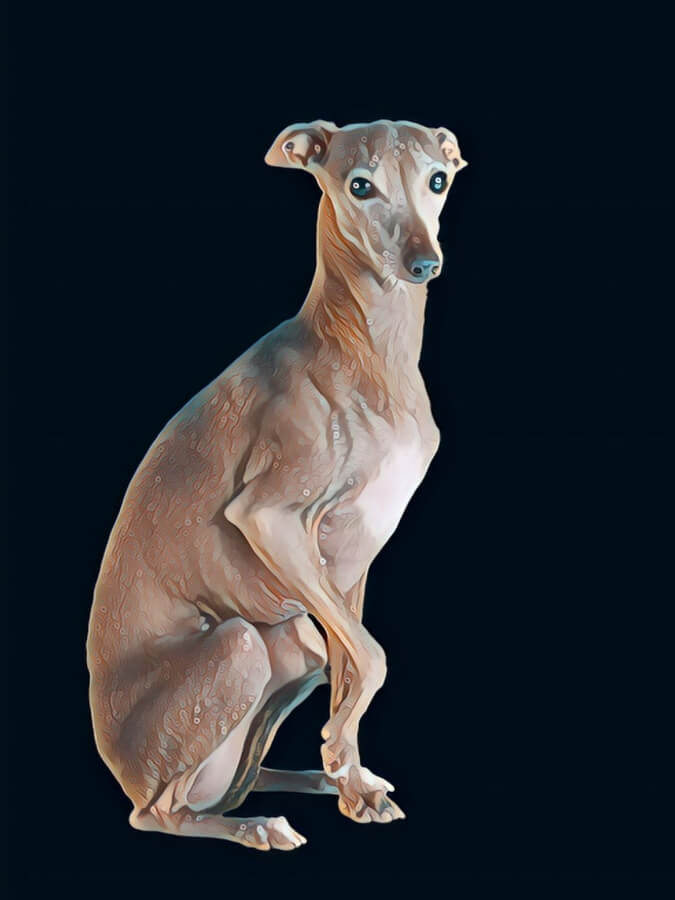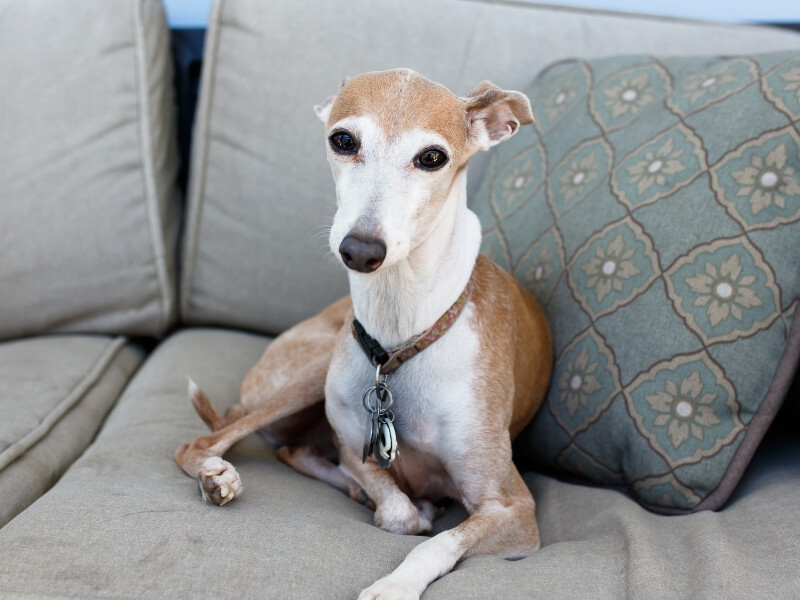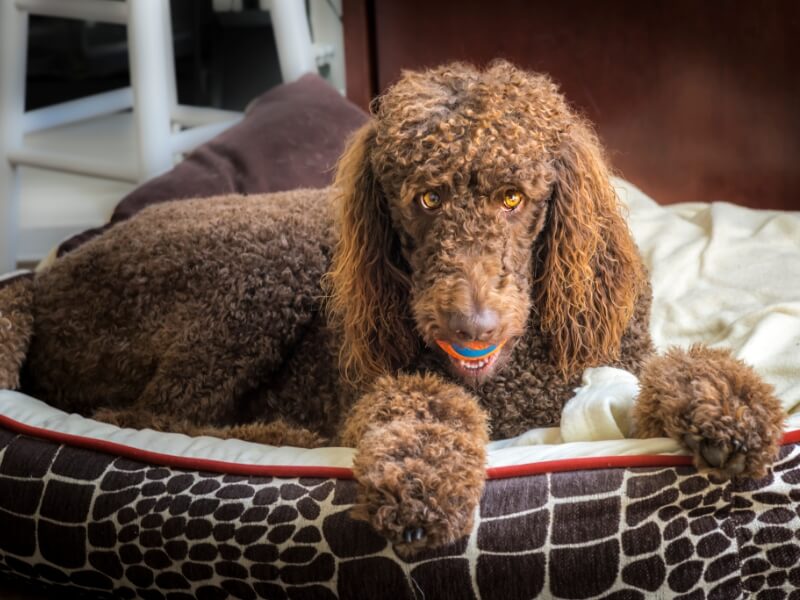Ever wanted a Greyhound but can’t keep it due to its size? Or have you always wanted a Poodle but disliked its hair maintenance requirements?
If you answered yes to either, you’d love the Pootalian. As a mix of the two, the Pootalian offers the best of both worlds—it’s smaller than the standard Greyhound and has a shorter, wiry coat that’s easier to maintain.
What is a Pootalian?
A Pootalian dog is a designer cross between a purebred Italian Greyhound (IG) and the standard Poodle. The Italian Greyhound is similar to the original Greyhound but smaller and leaner. This Doodle dog is also referred to as the Italian Greyhoundoodle or Italian Greyhoodle.
History of the Parent Breeds
What do Germany and Italy have in common? They adore their pups, allowing them everywhere, from restaurants to convenience stores. The two countries are also why the Pootalian, a popular designer dog breed, exists.
In this section, I will break down the history of the Italian Greyhound and the Poodle to shed light on the Pootalian’s inherited traits.
The Italian Greyhound

The Italian Greyhound is no new breed. It’s an old canine breed that evolved from the Mediterranean region about 2000 years ago. It has its roots in Ancient Turkey and parts of Greece.
Museum artifacts from the region exhibit depictions of the breed, and small remains of the dog have been discovered in the Mediterranean region [1]The Dog From Pompei.
Italian Greyhounds were most likely bred for small game hunting. By Renaissance, the IG had spread throughout Southern Europe and was especially famous in Italy for its uniqueness and sweet temperament.
It became the lapdog of Italian aristocrats, royals, and nobles, earning it the moniker Italian Greyhound. Evidence of the popularity of IGs in Southern Europe during the Renaissance is widely available in paintings of famous artists like Piscinello and Giotto.
The Italian Greyhound spread quickly throughout Britain and Europe, and by the 18th century, it had been recognized as an official dog breed by the American Kennel Club [2]akc.org/dog-breeds/italian-greyhound.
But despite its popularity, it nearly became extinct during the two world wars. Consequently, European breeders turned to the few Italian Greyhounds available in America to revive its European population.
Modern Day Popularity
Like most dog breeds today, the Italian Greyhound is a popular, super cuddly breed, often cherished as companion dogs. People love their adorable faces and quirky personalities; subsequently, you will find IGs all over Instagram and other social platforms.

IGs are super athletic and can run faster than any other dog breed. As a result, they’re also common participants in canine sports.
Poodle
The Standard Poodle originated in Germany, where it was known as “pudel,” meaning “to splash around.” The Poodle, a cross between water dogs, was valued for its exceptional water skills and was primarily used as a water retriever in the 16th century [3]akc.org/expert-advice/lifestyle/10-facts-about-poodles.

It is widely assumed to have originated in France. The confusion is logical, given that its popularity grew in France, where it is still considered the national dog.
Poodles are now found worldwide and make excellent house pets due to their cuddly and intelligent nature. They are lively, athletic, eager-to-please pups who quickly bond with their owners and, like the Italian Greyhound, frequently appear on canine sports runways.
Appearance
The Italian Greyhound is the smallest of all Sighthounds (also known as gazehounds). They have a sleek, slender bodies with long, fine-boned legs that give the impression of a high-stepping gait.
IG’s also have a narrow, almost flat head at the top and have a delicate, tapering muzzle with dark pigmentation around their medium-sized eyes and thin lips.
The ears are small and typically fold back along the neck but tend to angle upright to the right when the pup is alert. They have a long-arched neck, a deep, narrow chest, and a long but often low-set tail.
Poodles, on the other hand, are medium-sized, with a square stature. They have a long, moderately-rounded head, a slightly-chiseled muzzle with oval, wide-apart eyes, tight, pigmented lips, and long drooping ears.
Their tails are often set low but carried high or over the back and are proportional to their size in terms of length.
Subsequently, Pootalians vary in appearance but generally come as small-sized dogs with lean, sleek bodies similar to the IG. Pootalians have button-shaped eyes and short, floppy ears that are small to medium in size.
They have a small, always erect tail and, like their pure-bred, sighthound ancestors, have longer legs than bodies, though this varies depending on the dominant parental genes.
Coat Type
Italian Greyhounds spot a short, glossy coat with an incredibly short, satin-like hair texture that’s soft to the touch. Poodles have a dense, curly, or corded coat that’s often easy to clip. As a result, Pootalians have a short-to-medium coat with short, wiry, rough hair, almost like the Poodles.
Coat Colors
The most common coat colors seen on Italian Greyhounds are white, cream, gray, black, chocolate, red or blue fawn, tan, red, sable, blue, and yellow, or a combination of these.
On the other hand, Standard Poodles spot a dizzying array of coat colors. Aside from the standard black and apricot, Poodles with white, blue, gray, silver, brown, cream, café-au-lait, silver-beige, and red coats are also available.
Owing to the range of coat colors of their parent breeds, you will often find Pootalians in white, black, brown, parti, or brindle-colored coats. Some may spot a mix-colored coat.
Size
Both male and female IGs weigh 7 to 14 pounds. Poodles, on the other hand, differ in size depending on gender. Males typically weigh between 60 and 70 pounds, while females weigh between 40 and 50 pounds.
As a result, depending on the dominant genes, the Pootalian can weigh anywhere from 9 to 16 pounds.
Height
Male and female Italian Greyhounds reach a mature height of 13 to 15 inches. Poodles grow between 21 and 27 inches tall, with males typically larger than females. Pootalians, consequently, range in height from 8 to 15 inches.
Traits & Characteristics

Temperament
Italian Greyhounds might be tinier than the original sighthounds, but what they lack in size, they make up for in personality. IGs are typically alert, energetic, and intelligent.
They’re also affectionate and kind-mannered, making them eager to please and easily companionable. As a result, they get along with kids and other animals well. However, they can be strong-minded if they detect weakness in the owner.
As such, they require a strong-minded human who acts more like a pack leader in this regard.
Italian Greyhounds are athletic and can be trained for racing or as athletic dogs. However, if they had their way, they’d pick a nap and relaxation over exercise and training (just like I would).
They’re also obedient and easy to train but have a short attention span and need plenty of motivation to stay interested throughout training. However, keep in mind that Italian Greyhounds are sensitive and don’t respond well to harsh discipline.
Use positive reinforcement, such as treats, to get them to learn your tricks and commands. Even more surprising is that Italian Greyhounds can thrive in small spaces if they have enough room to stretch their long legs. Furthermore, because of their short coat, IG’s go cold easily and are best kept as indoor dogs.
Conversely, Poodles are also intelligent companions that quickly adapt to their environments. They’re also highly social and have strong loyalty tendencies making them excellent pets because once you bond with them, there’s no going back.
They require regular, close interactions with their owners and are affectionate and patient with children despite being highly energetic.
Pootalians are incredibly intelligent, active, and agile.
As noted, they’re intelligent, energetic, and highly active (no surprise they were once water retrievers). This trait not only makes them easy to train but also means they require lots of exercise.
The Pootalian, like its designer parents, is affectionate, intelligent, and eager to please. They have a big personalities and are incredibly protective and possessive of their human companions.
Good with children
As a result, they may sometimes portray aggressive tendencies towards strangers and other animals. This makes it critical for owners to socialize Pootalians early and familiarize them with kids.
Because of their instinctual aggressiveness, it’s difficult to predict their behavior towards children, so it’s best to keep one if you’ve got calm, sensible kids rather than roughhousing toddlers.
Chock full of energy
The Pootalian is also highly athletic but prefers to be a couch potato if allowed, like their Italian Greyhound parent.
Training your Pootalian
You should have no trouble training it because it’s always eager to please. Just be sure to keep it away from roughhousing toddlers, as it has aggressive tendencies and does well with humans who can display some dominance.
They’re also often eager to please their owner and, consequently, easy to train. However, like their ancestor – the Italian Greyhound, they lose interest fast, so include treats in your training sessions and make them brief.
Common Health Conditions
Although stronger than their purebred parents, Pootalians are also sensitive to health and conditions typical of the IG and Poodle parent. These include:
- Eye issues
- Skin problems
- Hip dysplasia
- Hypothyroidism
- Von Willebrand disease
- Intervertebral disc damage
- Epilepsy
- Addison’s disease
- Patellar luxation
Fortunately, as with any other breed, these health problems can be avoided with regular vet visits, a healthy diet, and regular exercise.
A thorough vet checkup should be sufficient to identify what health issues your Pootalian may be predisposed to, allowing you to address them through proper nutrition and supplements.
Lifespan
The Pootalian will also make your companion for quite a long time, usually between 12-16 years.
Italian Greyhounds have a pretty long lifespan. With proper care and maintenance, this unique dog breed can live up to 19 years, but it has an average life expectancy of 12-15 years.
Like its fellow parent breed, the Poodle also has an average lifespan of 12-15 years, with the oldest-ever recorded standard Poodle making it to 28 years!


